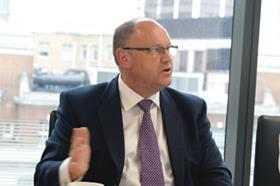It is now nearly six months since the Solicitors Regulation Authority’s new continuing competence regime became mandatory, amid concerns that dropping the 16 hours of compulsory CPD could result in less training being done.
While still early days, initial reports from regional law societies, firms and practitioners suggest moving to the new system has been ‘far easier’ than expected and ‘the reality is less of an issue than feared’.
SRA policy executive Richard Williams says feedback has been positive, with practitioners welcoming the new approach because it allows them to ‘tailor’ learning more closely to their needs without it having to be formalised. ‘It can be done on the spot, on mobiles and iPads, in the lunch hour or while commuting,’ he says.
The Law Society has published guidance and replaced its former CPD Centre with the Professional Development Centre (PDC), an enhanced e-learning portal which helps practitioners ‘select, collect and reflect’ on their training to meet the new requirements.
Questions remain, however, about the depth of awareness, both in private practice and in-house, given that those responding to surveys or approaching the SRA are those already engaged in the process and wanting to get it right.
It is therefore difficult to judge if any difficulties will arise. The SRA has committed to carrying out a full evaluation after the first annual declarations at the end of this year.
So, how are practitioners embracing the new requirements? How are training providers responding? And will the new requirements have an impact on disciplinary or regulatory issues or on professional indemnity insurance (PII)?
Allan Murray-Jones, who chairs the Society’s education and training committee, says both he and the Society were against dropping the hours-based approach, which they felt provided a framework which could not be ignored.
‘A couple of firms have told me they are taking the opportunity not to send people on courses so much,’ he says. ‘I would also be surprised if there hasn’t been some fall-off in training providers. I don’t get as many emails offering me training as I used to.
‘But we are hearing that people find the system quite easy to operate. Moreover, because of the way the SRA has set up the practising certificate renewal exercise, there is a good level of awareness about the new regime.’
He says the problem is that, while the ‘vast majority’ of firms are very conscientious, there will be a number who ignore the changes: ‘But if those firms are doing group PC renewals, they would be unwise not to make sure staff are genuinely completing their annual declaration about their training.’

Many firms are still finding their feet. Jane Jarman, reader at Nottingham Law School, says that while larger firms may already have mapped their training to the SRA competence statement, others may default to a ‘let’s just do 16 hours, or increase it to 24, and we will be OK’.
Training plans, as long as appropriate, do not have to be over-elaborate
— Jane Jarman, Nottingham Law School
‘And to be fair,’ she says, ‘if those hours are linked to the areas of practice, then it may well do the trick because training plans, as long as appropriate, do not have to be over-elaborate.’
Smaller firms with limited training budgets will benefit, she says, because they will not have to send practitioners on courses that do not really fit their needs just to get hours.
Instead, she recommends using the appraisal process to draw up training that focuses on areas that need to be ‘enhanced as well as cured’. These can include seminars and group discussions. Analysis and feedback can help develop future programmes.
What is clear is that training is a ‘volatile’ area, she says. Shorter online ‘bursts’ of training are becoming more popular: ‘We have to accept that those attending a course will have one eye on their smartphones and may be lost to any training that is over-long.’

Sole practitioner Hilary Underwood is finding it ‘incredibly easy’ to meet the new requirements. ‘We are inundated with emails from providers of training resources, whether face-to-face delivery of seminars, webinars or reading material,’ she says. ‘I have found no difficulties in sourcing appropriate training and resources to fill any gaps in my technical field of family law and in wider business skills.’
I have found no difficulties in sourcing appropriate training and resources to fill any gaps in my technical field of family law and in wider business skills
— Hilary Underwood, sole practitioner
She continues to choose ‘old school, face-to-face seminars, mainly because I work alone and find it stimulating to be with lawyers who can relate to the demands of practice’.
But she also ‘loves the flexibility’. She can fit training around her practice and focus on what she is trying to improve, rather than worrying about ‘clocking up hours’.
When it comes to in-house lawyers, Bill Graydon, CEO of the C&I Group, believes that ‘many are aware of the changes but not in any depth – and many haven’t got to grips with what they have to do to comply’.
The group offers its members four free webinars a year. Last year, two were devoted to the practical elements of meeting the new requirements, with another planned for this year.
Overall, course costs are kept down through arrangements with private practice firms, who prepare courses requested by the group’s training committee. ‘We pay for catering and sometimes premises,’ Graydon says. ‘What the firm gets in return is to show off its knowledge in front of in-house lawyers.’
There were predictions that the changes could lead to a ‘bloodbath’ in what is a very competitive training market. Providers now have to prove themselves to practitioners, since the SRA no longer accredits either them or their courses.
Prices have definitely been driven down, Underwood says, ‘particularly in the arena of face-to-face seminars, because fewer people are choosing them. This can only be good for me as a sole practitioner.
‘Online resources such as webinars are also cheaper. But hopefully it is just the prices that have gone down, not the quality. I am still very choosy and stick with my tried and tested favourites.’
It has not been a bloodbath so far, agrees Lucy Morrison, managing director of Central Law Training (CLT): ‘There is still demand for good quality training. Even if lawyers don’t have to attend a training course, it’s still an excellent way to bring yourself up to date and develop your skills. However, we may see further changes in the market as firms adapt to the flexibility and opportunities of the new regime.’
So, how are providers helping practitioners meet the competency thresholds, not just in black letter law but ethics and professionalism; managing yourself; and working with others?
CLT is reviewing the information it provides so practitioners can be clear what they will gain in terms of outcomes and competences. Examples include courses focusing on skills within a particular practice area, such as the Introduction to Document Drafting in Residential Conveyancing, and those, such as Conflicts and Confidentiality in Law Firms, which address core competences such as ethics.
Demand also remains high for all-day courses, Morrison says: ‘Sometimes that’s just how much time you need to cover a topic in sufficient detail. In our experience, not all learning is CPD-driven – some of our most successful courses are those that introduce practitioners to a new area of law and these can be up to five days’ long. But we also expect increased demand for half-day courses.’
Course prices have remained ‘pretty stable’, she adds. Full-day courses have increased by £10 to £240, while the cost of half-day courses has reduced in response to feedback. Members who commit to a minimum spend can access courses at £35 an hour, while £60 webinars cost £35 for those buying in bulk.
At BPP, Uche Onukaogu, CPD programme manager for law, says all the courses within its law offering are mapped according to the new SRA competences.
‘We are constantly reviewing our courses, but we already have a varied selection which addresses the competences either specifically or pervasively,’ she says. ‘Money Laundering & the Bribery Act’ addresses provisions within competence ‘A’ (ethics, professionalism and judgement) as well as competence ‘D’ (managing themselves and their own work).
Another course, ‘Managing the Client Relationship’, addresses provisions within competence ‘C’ (working with other people) along with competence ‘D’.
Bookings remain the same as last year, she notes. An increase in requests for online products is arguably down to flexibility, she says, rather than the new regime. ‘We have also seen a marked increase in firms looking for skills-based training, for example communications skills, business writing, management development programmes, to name a few,’ she adds. ‘This could be firms now feeling they have the freedom to determine what the specific learning and development needs of their teams are.’
What is critical is that practitioners record what they have done so they can sign with confidence the annual declaration that ‘I have reflected on my practice and addressed any identified learning and development needs’.
While the emphasis is on self-assessment, Jarman says firms also need to keep the SRA authorisation rules in mind. These make it clear that part of a firm’s compliance obligations includes having appropriate systems for supporting the training and development of staff.
If a firm has issues around claims or disciplinary issues, underwriters might ask questions around supervision and how the firm makes sure its people continue to develop their skills
— Richard Brown, Miller Insurance Services
Firms may already have existing recording systems (see box, below). The SRA has also produced a series of templates where practitioners can record how they planned and completed their CPD activities.
The Society’s guidance warns that the new regime is ‘not an excuse’ to avoid CPD activities. As a minimum, practitioners must consider their practice and learning needs. Practitioners who are confident there are no gaps in their competence do not have to do any CPD activities. But they will still need to make the annual declaration and keep records to show how they reached this conclusion.
The SRA has also stressed that its new approach is not a soft option and will be more robust because, Williams says, ‘it requires solicitors to think long and hard about their performance, rather than just attending training to accumulate hours’.
Developing staff is ‘in our DNA’

In such a complicated and risky practice area, she stresses: ‘If you take training away from this business, we don’t have a business.’
Jackson and husband Oliver set up the firm in 2009. ‘It was a struggle, when we started, to get lawyers of the right calibre and experience to come to a new start-up and take a risk,’ she recalls. ‘So we had to grow our own and training was crucial.’
Since then, the firm has grown from two to around 200, including 33 trainees. Private equity outfit NorthEdge Capital invested £15m in 2014 when the firm became an ABS and this year it was named Law Firm of the Year (medium-sized) at the Manchester Legal Awards 2017.
The firm records each fee-earner’s training on an internal system and encourages them to give feedback on its value – ‘and they are not afraid to tell us if a course was too basic or beyond their reach, so we rethink it’, Jackson says. Fee-earners flag up what training they feel they need at monthly 121s, while the firm makes sure everyone has satisfied the new competency thresholds at regular appraisals.
‘We also hold away days, when we take a batch of staff and ask them what we as a firm can do better. As the firm gets bigger, the more distant I can become from the client experience.’
The firm now has an executive training committee, with a sub-committee made up of different levels of fee-earners. ‘It sounds corny but the committee is the heartbeat of the firm,’ she says.
Jackson is conscious that many staff are young and have grown up with the firm, so she runs a keynote speaker programme where successful individuals, such as solicitor-advocate Joe Egan, who becomes Law Society president in July, discuss their career journeys.
The training budget has increased. ‘But it’s not about spending an inordinate amount of money,’ she says. ‘It is about identifying areas where you can drive the business forward . The biggest loss to a firm around training is less about the cost than the fee-earner’s time, so you have to make sure it is well spent.’
Given the inherently risky nature of the firm’s specialism, Jackson presents a detailed paper on the training programme for brokers and PII underwriters, to demonstrate the high level of competence.
‘Overall, I think the SRA’s approach around self-accountability has to be right,’ she says. ‘It should make practitioners think about how they want to approach their continuing competence. But while most firms will embrace it, there will be others under pressure which will see training as less important. So it will need to be reviewed in a year to see if it is working.’
He says the authority will be monitoring PC renewal forms to identify those who have not confirmed that they have reflected on their practice and addressed training needs.
‘We will use this information, in combination with other information we hold or receive about an individual or regulated entity, to explore concerns we may have with the competence or standard of service provided by a solicitor,’ he cautions. ‘Where we identify a concern, we may decide to engage with an individual or firm. Being able to provide evidence is therefore important.’

At present, PII underwriters are not asking specific questions about training. Richard Brown, head of solicitors at brokers Miller Insurance Services, says it is currently a ‘very soft market’, so underwriters are asking for relatively little information about clients or potential insureds.
He says: ‘If a firm has issues around claims or disciplinary issues, underwriters would want to understand what lies behind them. So they might ask questions around supervision and how the firm makes sure its people continue to develop their skills. But this is not something they are specifically focusing on at present.’
With the new approach still bedding in, how will the market evolve?
The flexibility and cost-effectiveness of online learning is driving huge take-up within the professional training market, Morrison says, but the legal profession is (to some degree) playing catch-up. ‘Over the next year, we will be developing online training that offers more interactivity than our current webinars,’ she says. ‘With ever-increasing demands on a lawyer’s time, we see focused, just-in-time training as essential.’
For Jarman, there is scope for firms to band together to buy courses or grow their own which better suit their business and the needs of their fee-earners, which ‘can only be a good thing in the long run’.
She also hopes that having a focused, well-resourced training programme that is analysed by senior lawyers and compliance officers will lead to a reduction in PII premiums.
‘This type of recognition,’ she says, ‘alongside COLP review of the process, could be a significant driver of change and enhance the profile of education and development within law firms.’
Nearly 45,000 practitioners now capture their learning through the Law Society’s Professional Development Centre (PDC), which is specifically designed to help members comply with the new continuing competence regime while managing their ongoing development.
Professional development centre
The enhanced e-learning portal replaces the CPD Centre, which focused on the collection of annual CPD hours. Some 40,000 of its active members have been transferred across to the PDC to join nearly 5,000 new members.
Helen Donegan, content manager responsible for the PDC, says members can record all of their training on the portal, including external training by other providers; assess themselves against the SRA competence statement; create personal development plans; and receive training suggestions tailored to their interests and competence needs.
The PDC provides training for the Society’s accreditation schemes, as well as interactive online courses, live and on-demand webinars, videos, quizzes and the newly designed free ‘bite-sized’ training. This includes 10-15 minute ‘smart-sized’ courses and 20-30 minute ‘LawTalks’, a response to member feedback that one of the biggest challenges they face with training is time.
Bookings remain at similar levels to the old regime. Those who are also members of one of the Society’s sections receive four free webinars a year, plus other discounts. CQS and WQS training is £60 per course but members of the accreditation scheme pay just £35 per course.
Donegan stresses that all the training content is matched against the SRA competence framework, so each piece of learning has the relevant competence within the A-D competence framework and subcategories applied to them. Excluding the mandatory accreditations training, she says: ‘The most popular content at the moment includes continuing competence advice, cybersecurity, and ethics.’
Grania Langdon-Down is a freelance journalist

















![David Lester (senior partner at Blythe Liggins), Darryl Barnes, Jagdeep Sandher (head of dispute resolution at Blythe Liggins)[4]](https://d1d8vslyhr7rdg.cloudfront.net/Pictures/274x183/4/2/8/116428_davidlesterseniorpartneratblytheligginsdarrylbarnesjagdeepsandherheadofdisputeresolutionatblytheliggins4_981603_crop.jpg)







No comments yet